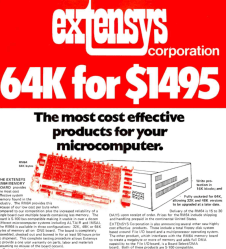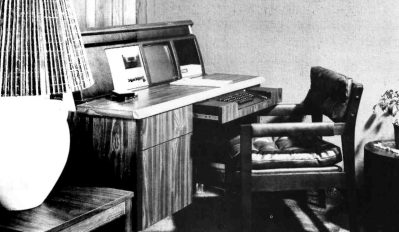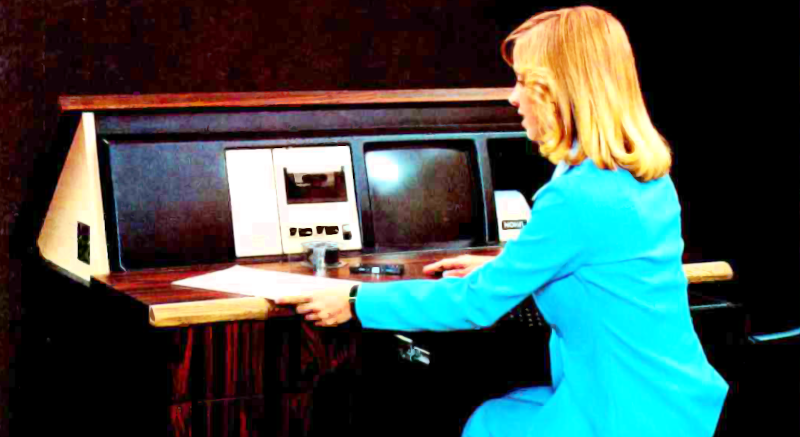People argue about the first use of the computer desktop metaphor. Apple claims it. Xerox probably started it. Yet, when I think of computer desktops, I think of the NOVAL 760. Not a household name, to be sure, but a big ad spread in a June 1977 Byte magazine was proud to introduce it. At $2995, we doubt many were sold, but the selling point was… well… it was built into a “handsome wood desk, designed to compliment any decor.” The desk folded down when you were not using the computer, and the keyboard recessed into a drawer.
 The computer itself was no slouch for 1977, but nothing you couldn’t find elsewhere. An 8080, speed unspecified, had 16 kB of RAM and 3 kB of PROM. There was also a display with a few kB of memory hanging around, too. And just in case you were worried, the bottom of the page entitled “The Ultimate in Home Computers” reads, “The NOVAL 760 COMPUTER. A fully-assembled, fully-tested personal computer … not a kit!” Of course, for us, that’s not really a selling point. If you wonder why the computer was memory limited, this is the time that Extensys bragged in an ad: 64 kB for $1495! If you ordered one, you could have it in 15 to 30 days, too!
The computer itself was no slouch for 1977, but nothing you couldn’t find elsewhere. An 8080, speed unspecified, had 16 kB of RAM and 3 kB of PROM. There was also a display with a few kB of memory hanging around, too. And just in case you were worried, the bottom of the page entitled “The Ultimate in Home Computers” reads, “The NOVAL 760 COMPUTER. A fully-assembled, fully-tested personal computer … not a kit!” Of course, for us, that’s not really a selling point. If you wonder why the computer was memory limited, this is the time that Extensys bragged in an ad: 64 kB for $1495! If you ordered one, you could have it in 15 to 30 days, too!
There were options for more memory, and it wasn’t clear how many of the I/O devices in the ad were actually included in the advertised price. Some of the devices seemed very specialized, so we are guessing the basic system didn’t include some of them.
Input/Output

According to the ad, you did get a lot of I/O devices, apparently, and they seemed to understand that software was the key to selling computers, although there wasn’t much of it about yet in 1976. The computer had a 12-inch monochrome monitor with 28 lines of 32 characters. If you used an external color monitor, the display could handle it. Don’t get too excited, though. An EPROM held four “schemes” of eight pairs of image and background colors. You could select any of the four schemes you wanted, but if you wanted anything else, you needed to burn an EPROM.
For mass storage, the computer had a “professional” mag tape system: a PhiDeck that could do about 2,500 bits per second. There was an audio tone generator that could have been anything from a buzzer to a crude sound card. A paper tape reader and, apparently, an EPROM burner — maybe for the color schemes, but we doubt they included an eraser. There was also a film reader, but it isn’t clear from the ad if that could scan film images (doubtful) or if it was some sort of read-only mass storage that they planned to use for distributing software.
Diskless
Notably lacking was a disk drive. They don’t mention a printer in the ad, but one was visible in the pictures — we guess it might have been an add-on and not included in the $3,000 price tag. The standard printer was an LRC printer that printed a raster image generated by the computer itself and matched the 32-character width of the monitor. Forward-looking but slow on a 1977-era 8080. Even the fact that the I/O drivers were in a ROM (what we would call a BIOS) and didn’t require fixed addresses to call was a selling point in 1977.
Games

Interestingly, the company couldn’t decide if it was a high-end business workstation or a game system. It had “dual hand-held keyboards for competitive game action, for the first time on a home computer,” according to the ad. They mention TELEMATH, a game where the computer presents math problems to two players, scoring for the first player to answer correctly.
They had some form of games from Gremlin Industries, apparently “the leader in commercial computer videographic and wall games” in 1977. We know them better as “a company bought by Sega.” Apparently, Gremlin was a “sister company,” although we don’t know the history there. We doubt Sega acquired it along with Gremlin since there is little information about the company after a big splash in 1977.
Assembly Required After All
The other software they seemed proud of was the editor assembler which was interactive and caught errors immediately. Back then, no one was sure what was happening with the computer industry. Maybe people were going to all learn assembly language. Maybe PCs would be sold in furniture stores. Maybe.
We wonder how many of these were ever out in the world. At least one still lives at the Computer History Museum. We don’t know exactly what happened to the company or if someone still has one of these in their spare bedroom collecting dust.
While computers did wind up in every home, it wasn’t like we imagined in 1977. At least they were closer than we were in 1962. The Noval was a big step up from a desktop computer of 1965.

















This is a silly construction, the desk cannot be closed if there’s anything connected to the expansion ports on the left.
btw, better pictures can be found here: https://archive.org/details/byte-magazine-1977-06 , p.81-84
Thank you for the tip! 😃👍
I love the readers adverts on the following page.
This company also released games for this computer see https://www.mobygames.com/company/33900/noval-incorporated/games/?title_id=1
It’s an ergonomical nightmare, but I love the loom of this desk and would build it in an instant if it were comfy!
I second that. I assume this computer was inspired by the Atari VCS, which had a “Chippendale” optics, too. Back in the 70s, esthetically pleasing furniture was still important to people. In some way or another, this was “smart furniture” already. In sports boats and sailing ships, they traditionally have similar functionality built into a wooden cabinet.
Oh! For some reason “Chippendale optics” garnered a different scene in my head.
I had to look up what chippendale furniture is too. I associate chippendales with either strippers or disney characters.
“Chippendale Optics”, no doubt something that you’d look at a bit cockeyed.
Well it does have that 70’s wood grain look so I’m sure somebody will build one.
When I saw it I was thinking how bad of an idea those sliding keyboard trays were. Then remembered the desk I’m sitting at has one. It’s only two years old! I can’t believe it has persisted for so long.
I use that tray! It holds my DVD player that never really needs to be pulled out and conceals the cables that snake around the back of the desk up to my TV on a high shelf.
Gives room for the tablet above it.
I saw the title,
got overly excited,
rushed to click thinking someone had made a replica of dillinger’s desk.
Anticipated sleek and sexy, got clunky bad scifi instead
I just want to hear the lady in the ad say: “we lost the bleeps, the sweeps and the creeps” 😂
+ 1 lol
I _so_ wanted one of those — cross between what “real” computer consoles looked like at the time and the “futuristic” appeal of having it rise out of the desktop.
In fact I have ideas for a hidden-PC desk design that I may tackle someday, though of course with modern solutions. Though I may steampunkify the design Just Because.
I remember seeing those in Byte in the seventies too, and my mind racing on building a console for my Z80 Starter Kit. Didn’t happen, but fun times.
The desk reminded me of the console of a WSR-88D.
That desk definitely was a looker at the first midwest personal computer convention at O’hare convention center. I figured that’s the way they’ll look in offices back then.
“ASSEMBLY REQUIRED AFTER ALL”?
2023 best to write machine language using a compiler … not an assembler?
Some machine codes which a compiler cannot produce can be produced
using figForth-like constructs of C, and , to put binary code into the compiler-produced machine language?
Evidently Gremlin created Noval to sell some gaming hardware they created that could be used as a full computer. This link has some details (with inaccuracies) https://www.tumblr.com/dieselpunkflimflam/171417851622/noval-760-computer-in-a-desk-circa-1977
The BASIC interpreter on Sinclair computers contained active syntax checker that made sure programs were correct, ON INPUT. It did not debug the program on entry, but check that each individual line made sense. I could not check if the code worked. I think brackets had to be an even number. You could still enter GOTO or GUSUB’s to lines that did not yet exist, but at least it had an onscreen editor which was quite an achievement for such a tiny ROM (4k or 8k for the ZX80 and ZX81) which also contained the OS and screen characters too!
Only about $15K in today’s dollars…
Mmm… 1974… wondering if the “Film Reader” was basicallyba MicroFische viewer…? A lot of stock manuals and inventory control data was being stored that way, as well as older government records. By 1977 the Hobart Corp. had transferred all of their various parts manuals for most of their production history over to MicroFische, reducing an entire 8×10-foot wall of shelved ringbinders to an 8×10-inch desktop index-card box with room for years of more new manuals.
I vaguely remember a HS acquaintance in the late 60s, early 70s, getting a computer from a company his dad was associated with. He asked me to help him get it working. I remember floppies and a half-height rack. There were a lot of these “minimally functional” designs in the 70s. Most of the companies lasted a few years, then vanished, leaving mysterious hardware (usually minus software) in their wake.
I did something similar way back in the day. I put a computer into a desk. The left side drawers were removed and housed the s100 motherboard, cards, power supply, and 8″ floppy drive. I tried mounting the screen about a half dozen different ways. Even tried having it under the desk with some glass to cover it. But ultimately, it got put on a pedestal, raised up about 12 inches off the desk.
The first version was in 1977. Eventually it was replaced by my IBM AT, which got mounted inside the desk (sideways).